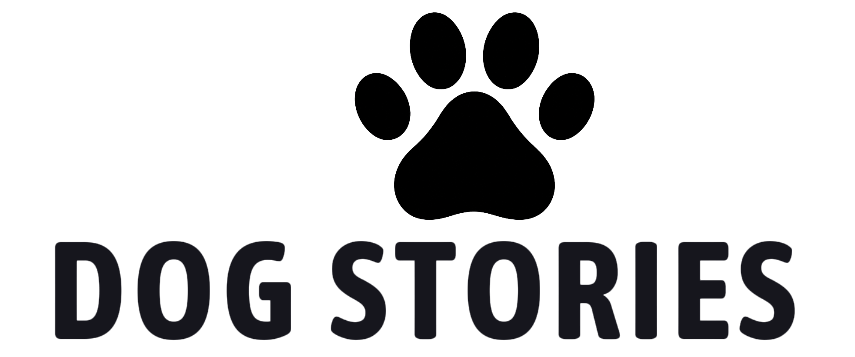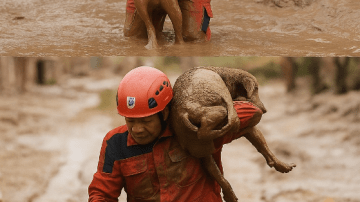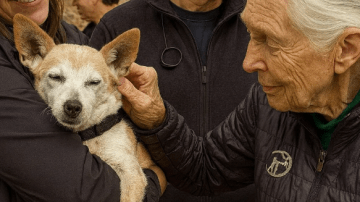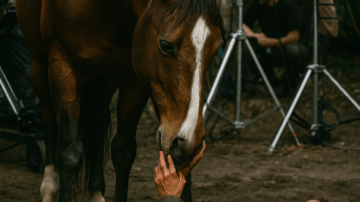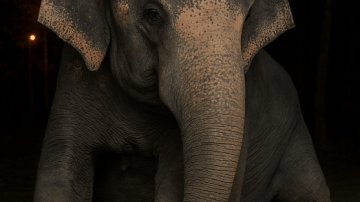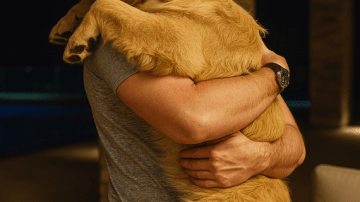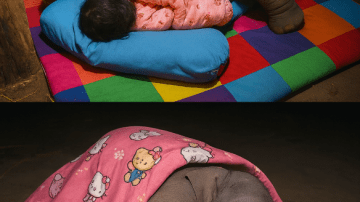The first call came in at dawn. A report of a dog, chained at a factory, gasping for breath. The words were simple, but behind them was a weight of suffering we couldn’t yet imagine.

When we arrived, the sight stole our voices.
There she was—an old female dog, barely able to stand. Every step was a struggle, her body swaying as though gravity itself was too heavy to bear. Her stomach bulged unnaturally, distended with fluid. Her eyes, sunken and weary, still held a spark of gentleness, but they were framed by exhaustion.
She tried to walk toward us. Slowly, painfully, one step at a time. And when she finally reached us, she did something remarkable—she leaned against my hand, nuzzling softly, as if to say, “I don’t know who you are, but please don’t hurt me. Please be kind.”
It was impossible to fathom the pain she had carried for so long. Years of neglect had carved scars into her body. Her nails were grotesquely twisted, curling inward from never being trimmed. Her ears, completely black inside, were clogged with filth. Her fur was patchy, matted, lifeless—a sad tapestry of years spent outdoors, unwashed, unloved.

We named her O-rae. It means “long time” in Korean—a name that reflected both the years of suffering she endured and the hope that she would live long enough to finally experience love.
At the clinic, the diagnosis was grim. O-rae was riddled with ascites, her abdomen filled with liters of fluid pressing against her organs. Beneath that swelling, she was nothing but bones. Each rib stood out like a marker of hardship. How long had she been like this? How many nights had she fought the pain alone, chained at that factory, while life went on around her?
We stroked her gently, whispering promises: “It’s going to be okay now. You’re safe.” But in our hearts, fear gnawed at us. Were we lying to her? Could she survive?
The vet’s hands moved quickly, inserting a needle into her abdomen. We watched in stunned silence as the fluid drained out, bottle after bottle. O-rae let out a long sigh, her breathing easing for the first time in months, maybe years. She closed her eyes, her body relaxing. For that moment, she looked almost peaceful.
It wasn’t a cure. The ascites might return. Her health was fragile, balanced on the edge of survival. But at least she wasn’t suffering in silence anymore. At least someone was fighting for her.

Day by day, we stood by her side. We massaged her frail body, we fed her small meals, we wrapped her in soft blankets she had never known before. And slowly, O-rae responded. She wagged her tail, weakly at first, then stronger. She looked up with eyes that no longer held just pain but also recognition—“These people care for me. I’m not alone anymore.”
Each time she walked across the clinic floor, her nails clicking against the tiles, she grew more confident. Her posture straightened. Her spirit returned. And with every gentle touch, every whisper of encouragement, her trust deepened.
O-rae, the factory guard dog, was transforming.
Weeks passed. The bones that once jutted through her skin softened under new layers of healthy weight. Her fur regained a shine. Her ears, once clogged and black, were treated and cleaned. The twisted nails were carefully trimmed, one by one. Her swollen belly flattened as treatment continued.
Most importantly, O-rae discovered something she had never truly known: love. She learned what it meant to be cuddled, to be spoken to with kindness, to be seen not as a tool but as a soul.
There were setbacks—days when her body fought against her, when the illness reminded us she was still fragile. But O-rae had already made a choice: she wanted to live. She wanted to fight for this second chance.
The turning point came one sunny afternoon. O-rae stepped into the yard, tail high, eyes bright, her gait steady and proud. She looked nothing like the skeletal, swollen creature we had first carried from that factory. She was radiant. She was whole. She was free.

Her beauty stunned us—not just her physical recovery, but the glow of her spirit. This was a dog who had every reason to give up, every reason to distrust humans. And yet, she had chosen love.
From that day, O-rae’s journey was no longer about survival. It was about joy. She greeted visitors with affectionate nudges, her tail wagging like a metronome of happiness. She learned to play again, to run short distances without fear of collapsing. Her eyes, once dimmed by suffering, now sparkled with confidence.
And so, O-rae’s story became a miracle.
The factory dog who had once been used and discarded, who had once been left to endure a swollen belly and twisted nails, now walked proudly into her new life. Her journey was a reminder of resilience, of how love can rewrite even the darkest stories.
She is no longer a dog defined by her pain. She is O-rae—the dog who endured for a long time, and who now has all the time in the world to be loved.
Her transformation wasn’t just physical. It was proof of what happens when compassion meets perseverance. Proof that no matter how deep the scars, healing is possible.
O-rae’s happy journey has just begun. And for her rescuers, for everyone who supported her, one truth shines brighter than all others:
All O-rae ever wanted was a warm touch and love. And now, at last, she has both.
